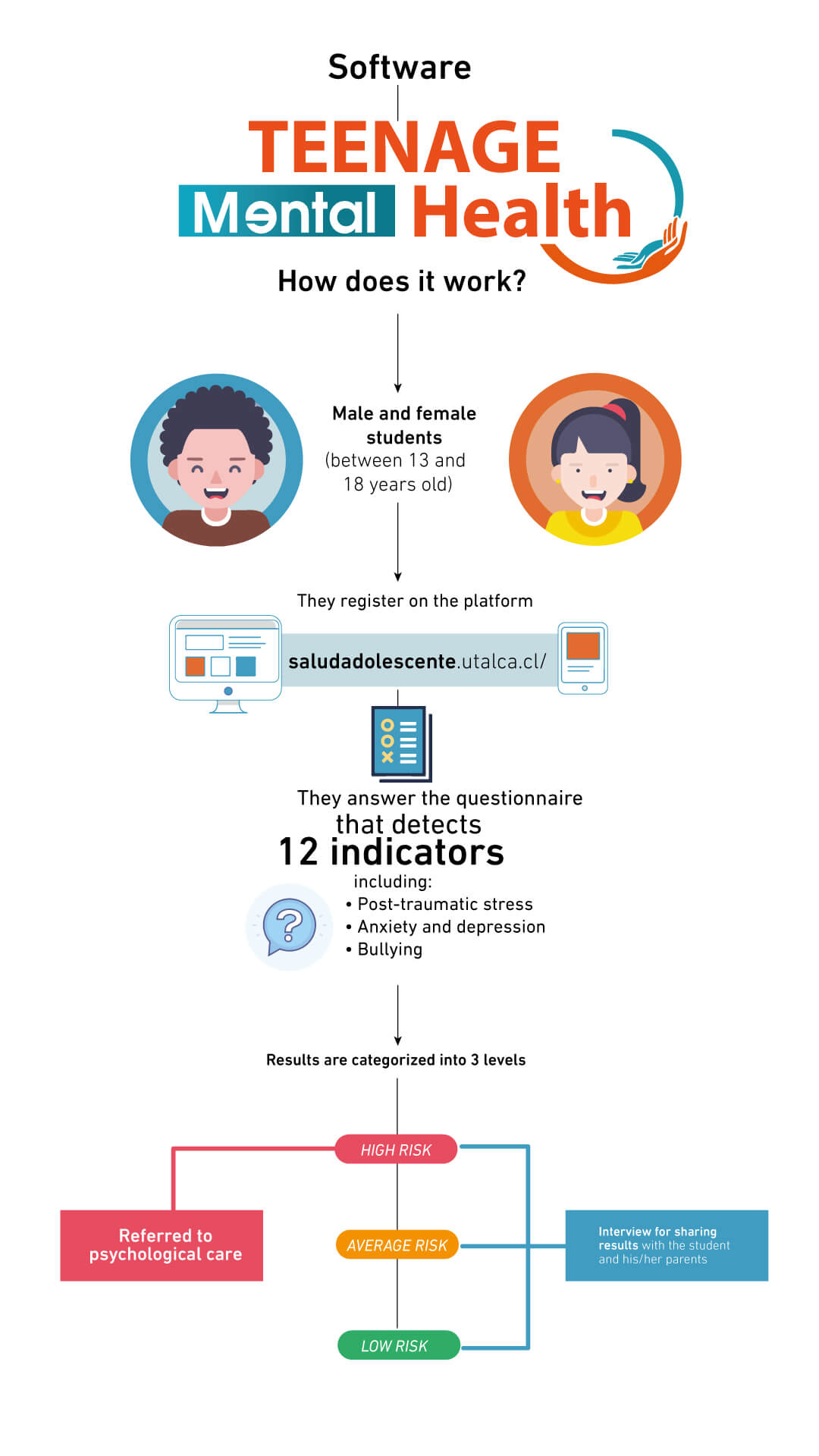Cargando 0%
Cargando 0%
The software, created by researchers of the Department of Psychology targeting prevention, has already identified 183 cases of at-risk teenagers in the Maule Region, 73% of whom are receiving specialized care.
9 Septiembre 2019
Over the last 10 years, 1,030 suicides were recorded in Chile of people between eight and 18 years old, according to data released in January 2019 by the Ministry of Health. The same report indicated that, in 2015, there were 309 deaths of children, adolescents, and young people who decided to take their own lives. In this regard, parents, educators, and specialists share a concern for being able to detect in a timely manner the risky behaviors that can lead a minor to make such a decision, which is exactly what the software developed by researchers from the Department of Psychology of the University of Talca does.
According to the study ” Mental Health of Children and Teenagers in Chile and Health Care Gaps”, in Chile 33.2% of the population between 12 and 18 years old has such problems. Meanwhile, data reveals that 15.7% of teenagers present nervous disorders, 12.8% show disruptive behavior, and 10.1% have disorders caused by substance problems.
The software, developed by professors of the University of Talca, enables the early detection of risk indicators of mental health disorders and suicidal behavior among teenagers. “The data shows that the software is able to identify people who, being at risk, had not been detected by schools, psychologists, and health facilities,” said project manager and university professor Daniel Núñez.
Since March 2019, both practical and fieldwork have been carried out, already producing results: out of the 1,388 teenagers surveyed, in 183 cases the schoolchildren were found to be at risk. Of these, 73% are currently receiving specialized care.
In the Maule Region, nearly half of people under the age of 20 have some kind of risky behavior. According to numbers provided by the Maule Health Service, 22.4% of children, teenagers, and young people in that age range show anxiety disorders, 7.2% behavioral problems, and 4.2% depressive symptoms.
The software has already been applied in nine schools, in seven communes of the Region: Talca, Curicó, Linares, Molina, Pelarco, Cauquenes, and Constitución.
The project, funded by the Maule Regional Government’s Innovation Fund for Competitiveness (FIC by its acronym in Spanish), administers a questionnaire aimed at detecting symptoms, which can be answered through a computer, notebook, or tablet. Then, the answers are processed with the software.

Results
According to the results of the intervention, 36% of the 183 teenagers with problems had never received any kind of intervention. In addition, 20.2% have had one or more pre-detection suicide attempts.
Núñez detailed that 73% of schoolchildren who were identified with serious problems were referred to psychological care. “The main behaviors that can be seen in a teen who is at risk are: symptoms of anxiety, depression, excessive alcohol and drug use, some eating disorders, suicidal ideation at some time in their lives, and post-traumatic stress,” he said.
Meanwhile, Cristóbal Latorre, a psychologist at the Liceo Valentín Letelier in Linares, highlighted the support provided by the use of the software at the high school: “It was possible to discover new cases that had not been identified.”
By applying this technology, the following results were identified among the teenagers; 36.3% presented anxiety symptoms; 31.8% presented depressive symptoms; 24.7% presented symptoms of post-traumatic stress disorder; 11.8% presented symptoms of eating disorders; 12.3% presented suicidal ideation during the month, and 20.6% presented suicidal ideation during their life.
Rosario Spencer, a professor at the Department of Psychology of UTalca, who is also part of the project, indicated that the main factors that lead to the occurrence of mental health disorders in teenagers are family violence, child abuse, alcohol, and other types of drug abuse.
Spencer explained that it has also been identified that students who repeat classes have worse mental health indicators in virtually all symptoms. While this does not allow for conclusions about causation, she said it shows that mental health is an important factor associated with academic performance.
UTalca researchers believe that, if the software is accompanied by a good reference and counter-reference system, between health and education, it could be a useful tool for early detection, before mental health crises and suicide crises occur, in a significant number of teenagers.
“There is much evidence that mental health problems can be successfully addressed if they are detected in time. Prevention is a feasible alternative for a large number of mental illnesses, and in this regard, educating the population to identify initial indicators that can prevent the onset of disorders generates benefits for the affected person, for public policy, and also has a positive economic effect because high costs in treatments can be avoided,” concluded professor Daniel Núñez.
Photo gallery